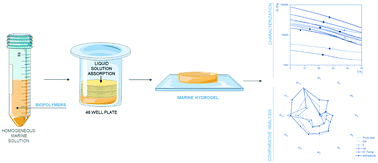Innovative methodology for marine collagen–chitosan–fucoidan hydrogels production, tailoring rheological properties towards biomedical application
Abstract
Marine polymers such as collagen, chitosan, and fucoidan can be combined to form ionic-linked hydrogel networks towards applications in tissue engineering (TE). The use of greener approaches (as determined by green metrics – E-factor), including the absence of external chemical cross-linking agents, has advantages regarding the potential cytotoxicity. By tailoring the formulation of such an ionic-linked hydrogel, it is possible to fine-tune scaffold biofunctionality. In this study, a comparative study of composite hydrogels was accomplished, seeking to understand the correlation between polymer characteristics and physical behaviour to develop the applicability of this technology in soft-to-hard TE. Parameters such as polymer concentration, molecular weight, polymer-biomaterials bonds, biomaterial structural architecture, pore size, and mechanical rheological properties were directly correlated to the hydrogel's formulation. The results highlight that the formulation with greatest potential was the 3-component hydrogel (H12, followed by H10, H11), due to its superior mechanical properties, making it suitable for cartilage TE. This research offers a valuable perspective on hydrogel formulation and a new processing methodology, as well as how tailoring the hydrogel composition influences mechanical behaviour to support selecting the best composition for tissue engineering applications.

- This article is part of the themed collection: Marine-based Green Chemistry


 Please wait while we load your content...
Please wait while we load your content...